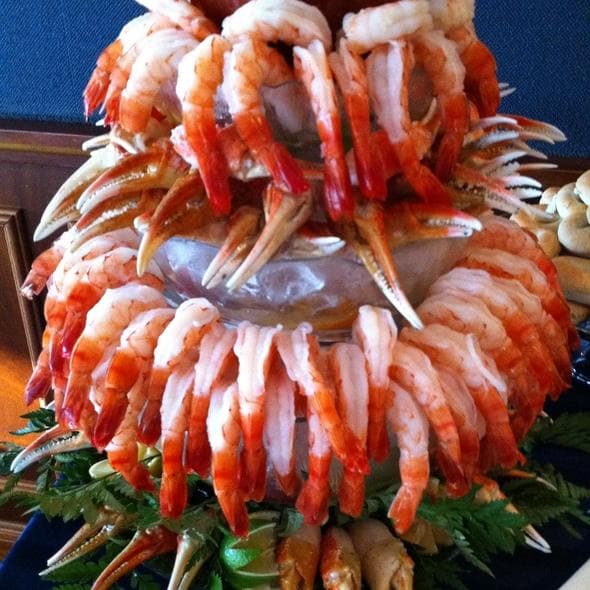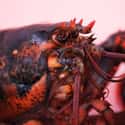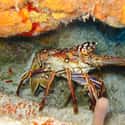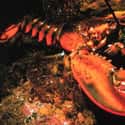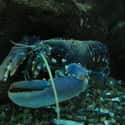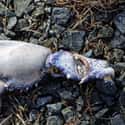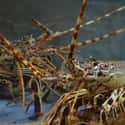-
(#1) Lobster Was Once A Peasant's Food
Lobsters are probably most famous for being a really expensive delicacy, but that was not always the case. Lobsters were once so abundant in North America the Native Americans would use them as fertilizer, bait, and a good source of protein. They showed the settlers how to cook lobster, a process that included wrapping them in seaweed and steaming them over a fire, which would eventually evolve into the famous New England clambake.
In the early days of colonization, there were so many lobsters they became the staple food of servants, prisoners, and slaves. People were being fed so much lobster they revolted. Laws were passed limiting the amount of lobster that could be fed to prisoners, and many workers demanded in their contracts they were to only be fed lobster three times a week.
-
(#2) They Can Shoot Pee Out Of Their Eyes
Females are known to squirt males with pungent urine in an effort to begin the courtship process. Dr. Ellen Prager, a marine biologist and professor, described the practice to NPR. "She shoots when she comes up to a den that might have a male in it. She actually seduces him with her pee and instead of clobbering her over the head with his claw, he says, 'Come in, come in' and gets all touchy-feely.”
It’s not all about romance though. Lobster urine contains a lot of information, and spraying pee in someone's face is apparently a valid form of communication for them. Males have been known to pee in each other faces to display aggression and dominance over rivals.
-
(#3) They Basically Don't Have A Brain
Lobsters are simple minded creatures, and that's not a diss. Their brains are extremely primitive, closely resembling those of insects. Their "brains" are really just a cluster of nerves that regulate their entire existence. The collection of ganglia (nerve endings) that make up the brain is about the same size as a grasshopper brain. This lack of sophistication has led many to believe that lobsters actually can’t feel pain, although this claim has been disputed in the past.
-
(#4) They Can Taste For Prey With Their Legs
Lobsters have a lot of limbs. Between the claws, legs, antennae, and swimmerets, it’s a wonder they can keep track of them all. Amazingly, the American lobster has two sets of legs that have the unique ability of being able to “taste” for their food. The tasting legs are set just behind the claws and are full of receptors designed to help the lobster locate food in the area. The legs are just a few of the sensory tools that lobsters use to detect prey, the others being their antennae, eyes, and mouths.
-
(#5) When Mating, Females Have All The Power
Lobster mating is a complicated process, but one that empowers the females. Mating is almost always instigated by the females, who release sex pheromones to inform nearby males they are ready to mate. Lobster males will often fight for a female, and the victor will watch over the her until she completes a molt. To have sex, the females must remove their exoskeleton before mating. Essentially, they strip for their partners. The males will spend up to two weeks protecting their mates from predators while they are naked and vulnerable.
Sex is no guarantee that the male's genes will be passed on, however. Female lobsters are able to hold onto a male’s sperm for up to 15 months and decide when is the right time to lay their eggs. They can store between 5,000 and 100,000 eggs under their tails until they are ready to hatch.
-
(#6) They Live For A Long Time And Never Stop Growing
In 2013, the Internet exploded with articles about how lobsters are functionally immortal. This isn't entirely true. It's based on the fact that lobsters do live a long time. The lifespan of European lobsters (Homarus gammarus) averages about 31 years for males and an astounding 54 years for the females, with some making it past the ripe old age of 70.
The misconception that lobsters can live forever is most likely due to their slow rate of senescence, or the process of aging. Lobsters never stop growing throughout their life, unlike mammals who grow rapidly during their adolescence but stop once they hit adulthood. This slow-but-steady approach to growth reduces the rate of decay in the lobsters' cells and allows them to live for a long time. The largest lobster ever recorded was a 44 lb monster caught off the coast of Nova Scotia. In the US, the biggest lobsters are thrown back to help bulk up the gene pool.
-
(#7) Lobsters Have Three Stomachs, One Of Which Has Teeth
Lobster anatomy never ceases to amaze, and the digestive tract is no exception. American lobsters don’t have any teeth in their mouths, but they do have some in one of their two stomachs. That’s right, lobsters chew their food in their stomach with specialized teeth (known as a gastric mill) that grinds their food into mush. Once chewed, the mush moves into the a second stomach, which absorbs the nutrients from the food. This bright green digestive gland is commonly known as the tomalley.
-
(#8) Lobsters Are Only Red After Being Boiled
There is a common misconception that all lobsters are bright red. Lobsters can come in a variety of colors, but none of them are all red. Lobster pigmentation can vary between species, but most of them are a dark mix of black, brown, red, and blue. There are some rare genetic defects that can cause extreme color variations, but they are not a species-wide phenomenon.
The red coloration is actually a result of the cooking process. Boiled lobsters turn red, and scientists recently discovered the mechanism behind this dramatic transformation. Two chemicals, crustacyanin and astaxantin, are responsible for the pigmentation of lobsters. Crustacyanin is responsible for the bluish tint of living lobsters, while astaxantin causes the red coloration. Crustacyanin overpowers astaxantin in living lobsters, but exposure to intense heat causes a chemical reaction that allows the red pigment to overpower.
-
(#9) Their Shells Can Be Used To Make Biodegradable Golf Balls
If you're the kind of person who has the money to regularly smack golf balls into the ocean from your yacht, you probably aren’t thinking too much about the massive damage you're causing to the environment. Researchers have studied golf ball degradation and determined it takes somewhere between 100 and 1,000 years for a normal golf ball to break down. Seinfeld famously joked about the perils of golfing at sea, but some people are taking the situation much more seriously.
David Neivandt, a professor at the University of Maine, was one of the people involved in an effort to reduce the environmental impact that golf balls have on our oceans. He spearheaded an effort to create biodegradable golf balls out of discarded lobster shells. His lobster balls were able to degrade in the ocean in one to two weeks, which is basically instant when compared to the alternative. Lobster shells being recycled into golf balls instead of being tossed into a landfill is an added environmental benefit with no additional negative effects on wild lobsters.
-
(#10) They Eat Each Other
Lobsters are bottom feeders who typically eat shellfish, crabs, and other invertebrates. Unfortunately, lobsters are invertebrates themselves and they are not above putting each other on the menu. One of the primary reasons that lobster claws are banded shut in captivity is to minimize the risk of them murdering and devouring each other before we can. At first lobster cannibalism was thought to only occur in captivity, but in the last few years they have been observed committing lobster-cide in the wild.
-
(#11) Lobsters Don't Scream, But Their Bodies Do (Sort Of)
The traditional method of cooking lobsters is to boil them alive, and it’s no surprise many people and organizations find that cruel. Some people point to the infamous “scream” lobsters emit when they are being cooked as a sign they are in great pain. Except that's impossible, because lobsters can't scream.
Lobsters lack vocal cords, and are therefore unable to make any vocalizations, much less a scream. They are completely silent creatures. So what’s that noise they make when you cook them? As the lobster boils, air builds up under their carapace until it finally releases. The sound you hear is that steam escaping, much like the sound a tea kettle makes when it’s ready.
-
(#12) Lobster Claws Are Insanely Tough And Can Regenerate
Lobsters belong to the order Decapoda, which literally translates from Greek as “10 feet.” Like all decapods, lobsters have five pairs of legs. In some lobsters, the front pair of legs has evolved into a pair of durable claws. While not all lobster species have claws (like the Caribbean spiny lobster), the ones that do can be pretty formidable. A lobster can pinch with the force of 1,180 psi, which is stronger than the bite of a dog.
Clawed lobsters typically have two different types of claw, one designed to crush and the other to pinch. The cutter claw is smaller than the crusher, which is used to break into hard-shelled prey like clams. In the event a lobster loses one of its claws, the lost limb will simply begin regenerating during its next molting cycle. A one-clawed lobster is typically known colloquially as a cull.
-
(#13) They Can Swim Backwards
Lobsters typically move by crawling across the seafloor, but they can also be very agile in a pinch. Using their powerful tails, lobsters can shoot backwards to quickly swim away from any predators daring enough to attack these armored crustaceans. Scientists and mathematicians have studied lobsters to determine just how they manage to move like they do, and they determined that the motions are simply hard-wired into them as a reactionary defense mechanism.
-
(#14) 248 Species Of Lobster Have Been Discovered
There are a lot of lobsters out there, all with their own unique properties that make them awesome. About 250 species have been identified to date, and they can be divided into two distinct groups; clawed lobsters like the American and European variant, and clawless "rock" lobsters like the Caribbean spiny lobster. These amazing creatures can be found all over the world, in every ocean on the planet. No matter were you are on Earth, these crustacean critters will probably show up on the menu.
New Random Displays Display All By Ranking
About This Tool
When you think of lobster, most people think of the bright red delicious food that you see on a dinner plate. Lobsters are marine invertebrates protected by a hard exoskeleton that supports their body structure. They are mainly distributed in tropical waters, and also the largest species of shrimp. Lobster has become one of the most popular seafood around the world, but most people know very little about its real life.
Despite their reputation as a delicious dish, lobsters have some fascinating facts that most people never know. You could Learn 14 amazing things about this iconic marine creature in this random tool.
Our data comes from Ranker, If you want to participate in the ranking of items displayed on this page, please click here.

